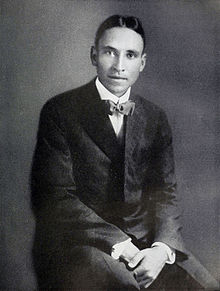Edmund Newton Harvey
Edmund Newton Harvey , called Newton Harvey , (born November 25, 1887 in Germantown , Philadelphia , † July 21, 1959 in Woods Hole , Massachusetts ) was an American pioneer of bioluminescence .
Life
Harvey studied at Germantown Academy and the University of Pennsylvania and received his doctorate in 1911 under Thomas Hunt Morgan at Columbia University (The permeability of cells). His interest in bioluminescence arose in 1913 on a South Pacific research trip under the direction of Alfred G. Mayer, who had been a professor at the University of Pennsylvania. He did research under Edwin Conklin at Princeton University , where he became an instructor in 1911, an assistant professor in 1915 and a full professorship in 1919. In 1933 he succeeded Conklin Henry Fairfield Osborn Professor . In 1956 he retired.
In 1916 he married the biologist Ethel Nicholson Browne and on his honeymoon in Japan he became acquainted with the luminous cancer Cypridina hilgendorfii , which was to become his research object and which was very well suited for studying bioluminescence ( luciferin- luciferase system).
He wrote a history of luminescence .
In 1947 he received the Rumford Prize . He was a member of the American Philosophical Society since 1929 and of the National Academy of Sciences since 1934 . In 1948 Harvey was elected to the American Academy of Arts and Sciences .
Fonts
- The nature of animal light. Lippincott, Philadelphia 1920.
- Living light. Princeton University Press, 1940
- Bioluminescence. Academic Press, 1952.
- History of Luminescence from the earliest times to 1900. Memoirs American Philosophical Society, 1957.
Web links
- Entry in the Encyclopedia Britannica (English)
- Frank H. Johnson, Biographical Memoirs National Academy (PDF; 1 MB; English)
Individual evidence
- ↑ This was previously his teacher at the University of Pennsylvania.
- ^ Member History: E. Newton Harvey. American Philosophical Society, accessed September 23, 2018 .
- ^ Members of the American Academy. Listed by election year, 1900-1949 ( PDF ). Retrieved October 11, 2015
| personal data | |
|---|---|
| SURNAME | Harvey, Edmund Newton |
| ALTERNATIVE NAMES | Harvey, Newton |
| BRIEF DESCRIPTION | American zoologist |
| DATE OF BIRTH | November 25, 1887 |
| PLACE OF BIRTH | Germantown , Philadelphia |
| DATE OF DEATH | July 21, 1959 |
| Place of death | Woods Hole , Massachusetts |
